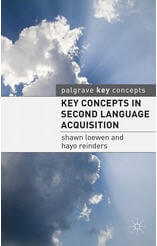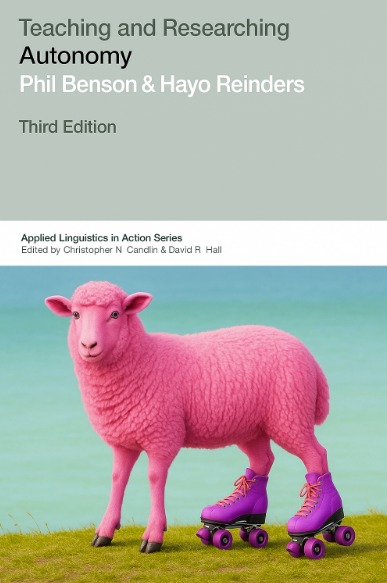Books > Key concepts in sla

Loewen, S. & Reinders, H. (2011). Key concepts in second language acquisition. Palgrave Macmillan.
Introduction
What is second language acquisition and why do we need a key concept book on it? The study of second language acquisition (SLA) has become an area of academic study in its own right over the last several decades. It is housed, so to speak, within the larger discipline of applied linguistics, which in turn can be viewed as a specialized area of linguistics. However, while linguistics is primarily concerned with describing language and explaining first language acquisition, applied linguistics is more concerned with the practical applications of language in society. One of those practical applications is how people go about learning a language other than their first one. While it is possible that much of the early research into second language learning was primarily concerned with pedagogical applications, over the decades SLA research has not been concerned just with classroom applications, but it has also begun to try to explain the processes of second language acquisition without necessarily considering the implications for classroom teaching. This formalization of SLA as an academic discipline has coincided (probably not accidentally) with the growth of the second language industry. While people have been learning second languages throughout history, there are now considerable economic resources expended to teach additional languages throughout the world. This economic reality has further increased the number of people who are concerned with teaching second languages and studying the science of SLA. Thus, the need for a book that provides a basic entry into the world of SLA.
Before getting into the details of SLA, it is important to consider the parameters of SLA. We would like to do that by considering each of the terms in turn. Although the official name of the discipline is SECOND language acquisition, it is generally acknowledged that this term refers to any language that a person learns after their first language. There is general agreement that people begin learning their first language without much difficulty from birth. In contexts where only one language is spoken, there is very little controversy over what is a first language. (First language has also been referred to as mother tongue, native language, primary language, etc.) However, the situation is more complex in multilingual settings where a child might grow up learning two languages simultaneously. Additionally some people may learn one language at birth but then may become dominant in a different language. The general consensus, though, is that in most contexts it is clear what a person’s first language is. Therefore, the next language that is learned subsequently, if any at all, is considered the second language. However, people are not limited to learning just a second language, they may learn a third, fourth or potentially greater number of languages. Sometimes these languages are called third or fourth languages (and there are studies of trilingual acquisition or multilingual acquisition), but often these languages are also called ‘second’ languages as well. Sometimes the term ‘additional language acquisition’ is used to avoid referring to any order of acquisition after the first language. However, such terminology has not gained popularity, and the field has been and continues to be called ‘second language acquisition’, even though SLA researchers acknowledge that the term applies more to just the chronological second language.
The next term to consider is ‘language’. Again, at first glance this term seems fairly unproblematic as every person speaks a language and individuals can name several of the world’s major languages. However, when we look more closely, we find that the definition of language is somewhat more problematic. The study of linguistics has contributed some information in this regard, and they have traditionally divided the study of language into grammar (morphology/syntax), vocabulary (lexis/semantics) and pronunciation (phonology). Recent additions to the above categories have included pragmatics, which investigates how people use language to accomplish various things, such as making requests, apologizing, etc. In addition, pragmatics is concerned with how people express politeness and how different styles of language can be used in different social contexts. Another aspect of language has been called discourse, and this area is concerned with how language is used to structure texts, such as stories or expository essays, that are longer than a sentence. In addition to these linguistic components of language, there is also no agreement of how to define a language. If we take English as an example, it might seem fairly straightforward if we say someone is learning English as a second language. However, there a different types of English (these are often called dialects). Some of these dialects are regional. For instances, learners may want to learn British English or American English, depending on where they live. There are also different varieties of English in Canada, Australia, New Zealand, India, etc. Generally, one variety of English is generally understood by speakers of other varieties of English, but there are abundant opportunities for misunderstanding. Just ask any speaker of British English who has asked for a rubber (eraser) in America, or an American speaker who has referred to their fanny pack (bum bag) in New Zealand.
In addition to regional variation in a language, there is also social variation, and sometimes there are social judgments that are attached to these varieties. So for example, a standard language refers to a variety of language that is viewed as a socially prestigious form of the language. However, linguistics view non-standard varieties of languages to be just as valid and systematic linguistically as standard varieties, but non-standard varieties may be viewed as socially inferior. Nevertheless, learners of a second language may wish to learn a non-standard variety of a language, if that is the primary language that is spoken in their social context. Finally, there are political distinctions that are made in regard to what is considered a language. Languages such as Norwegian, Swedish and Danish, or Hindi and Urdu, or Serbian and Croatian are largely mutually intelligible, but they have been determined to be ‘languages’ for political or cultural reasons. In contrast, languages such as Mandarin, Cantonese and Hakka are all referred to as Chinese, even though they are not mutually intelligible. As can be seen from the above discussion, the term language in SLA is more complex than one might first think.
Finally we come to the term acquisition. What does it mean to acquire a language? First, we might want to make a distinction between being able to use a second language for communication or being able to describe the rules for that language. Some SLA researchers have referred to this distinction as the difference between acquisition and learning; however, this distinction is not universally agreed on in SLA. Another issue to consider is how much of the language is needed to say that acquisition has taken place? It is generally agreed on that the majority of second language learners do not achieve native-like proficiency in a language. But what level of mastery is necessary to say that a language has been acquired? There is no agreement regarding this question, and indeed some SLA researchers prefer the term development rather than acquisition.
This book, then, provides an opportunity to consider these issues as we present some of the important concepts in the study of second language acquisition. The scope of this book includes important terms and ideas related to SLA; however, it is important to specify the decisions that we made regarding which terms to include or exclude. Any terms that are unique to SLA are obviously included. Terms and theories from other disciplines, such as education or linguistics, have also been included if they have been influential in SLA (e.g. Sociocultural Theory or Universal Grammar). This book also includes terms that relate to SLA research practices. On the other hand, this book excludes terms that are primarily sociolinguistic or linguistic in nature and that do not relate directly to L2 learning. This book also does not include grammar explanations, nor does it include terms that are only related to teaching methodologies. Although we have tried to be principled in our selection of terms, in some cases, judgment calls, based on our own experiences as SLA researchers, were made about the inclusion of specific terms. As a result, there may be terms that were omitted that others feel should have been included. In contrast, there may also be terms that are included that others feel are peripheral. Nevertheless, in the end we feel that we have presented comprehensive coverage of the key concepts in SLA.


